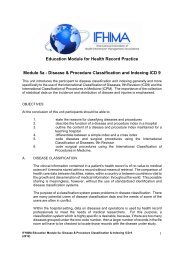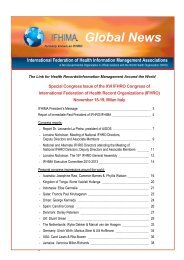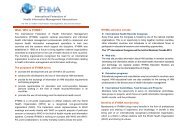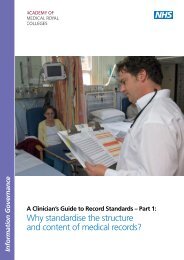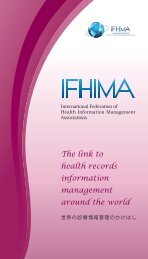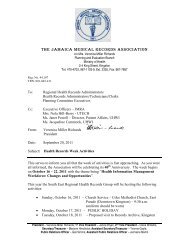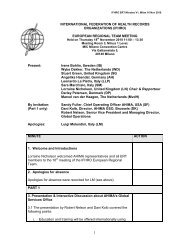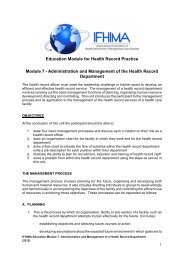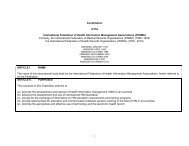Learning Packages for Medical Record Practice - ifhima
Learning Packages for Medical Record Practice - ifhima
Learning Packages for Medical Record Practice - ifhima
Create successful ePaper yourself
Turn your PDF publications into a flip-book with our unique Google optimized e-Paper software.
) Lateral open shelves are preferred as considerably more records can be<br />
filed on open shelves than in cabinets within a given filing area.<br />
Also the aisles between units require less space <strong>for</strong> shelves than <strong>for</strong><br />
drawers. The normal aisle space <strong>for</strong> open shelves ranges from a<br />
minimum of 75 cm (30 inches) to 90 cm (36 inches).<br />
For cabinets facing each other, a minimum of 1 meter (3 feet) is<br />
necessary.<br />
Management of records is much faster on open shelves as there is no<br />
need to open or close drawers and the file clerk has a better overview,<br />
when standing in an aisle. Guides can be easily seen in open shelves,<br />
but are almost useless in drawers.<br />
Open shelves are usually less expensive but drawer cabinets give better<br />
protection against dust and dirt.<br />
c) Mobile or compressible shelves maximize the floor space. On the other<br />
hand it is usually very expensive and not very useful if several employees<br />
have to enter the files simultaneously, because of the limited access, as<br />
only one aisle is provided <strong>for</strong> several rows of shelves.<br />
2. Filing supplies<br />
a) <strong>Record</strong> folders<br />
<strong>Record</strong> folders have a double role. They protect and identify the medical<br />
record. When buying folders one should look at composition, size,<br />
expandability, rein<strong>for</strong>cement and possibilities <strong>for</strong> tabs or attachments. A<br />
variety of folders are now available and include plastic, manilla or<br />
pressboard covers, large envelopes, folders with fasteners, with special<br />
pockets, with pre-printed colour strips and record numbers.<br />
Usually folders can be purchased with the hospital identification and other<br />
in<strong>for</strong>mation printed on the cover. A clear area <strong>for</strong> the patient's name and<br />
record number, however, should not be <strong>for</strong>gotten.<br />
b) Guides<br />
Guides should be placed throughout the files to assist finding and filing<br />
health records. The number of guides needed depends upon the<br />
thickness of the sections of the files. For medium thickness of records a<br />
guide after every 50 records is usually sufficient. For thicker records,<br />
more guides will be required. Usually with terminal digit filing two pairs of<br />
numbers appear on each guide. These are the secondary and primary<br />
digits.<br />
For example:<br />
IFHIMA Education Module 3: <strong>Record</strong> Identification Systems, Filing and Retention of Health <strong>Record</strong>s<br />
(2012)<br />
23



